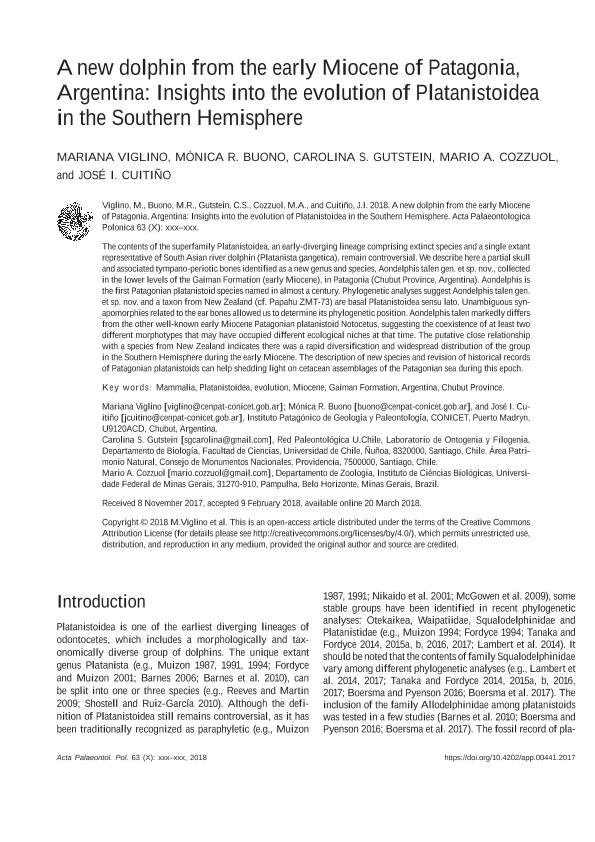Artículo
A new dolphin from the early Miocene of Patagonia, Argentina: Insights into the evolution of Platanistoidea in the Southern Hemisphere
Viglino, Mariana ; Buono, Mónica Romina
; Buono, Mónica Romina ; Gutstein, Carolina; Cozzuol, Mario Alberto; Cuitiño, José Ignacio
; Gutstein, Carolina; Cozzuol, Mario Alberto; Cuitiño, José Ignacio
 ; Buono, Mónica Romina
; Buono, Mónica Romina ; Gutstein, Carolina; Cozzuol, Mario Alberto; Cuitiño, José Ignacio
; Gutstein, Carolina; Cozzuol, Mario Alberto; Cuitiño, José Ignacio
Fecha de publicación:
03/2018
Editorial:
Polish Academy of Sciences. Institute of Paleobiology
Revista:
Acta Palaeontologica Polonica
ISSN:
0567-7920
e-ISSN:
1732-2421
Idioma:
Inglés
Tipo de recurso:
Artículo publicado
Clasificación temática:
Resumen
The contents of the superfamily Platanistoidea, an early-diverging lineage comprising extinct species and a single extant representative of South Asian river dolphin (Platanista gangetica), remain controversial. We describe here a partial skull and associated tympano-periotic bones identified as a new genus and species, Aondelphis talen gen. et sp. nov., collected in the lower levels of the Gaiman Formation (early Miocene), in Patagonia (Chubut Province, Argentina). Aondelphis is the first Patagonian platanistoid species named in almost a century. Phylogenetic analyses suggest Aondelphis talen gen. et sp. nov. and a taxon from New Zealand (cf. Papahu ZMT-73) are basal Platanistoidea sensu lato. Unambiguous synapomorphies related to the ear bones allowed us to determine its phylogenetic position. Aondelphis talen markedly differs from the other well-known early Miocene Patagonian platanistoid Notocetus, suggesting the coexistence of at least two different morphotypes that may have occupied different ecological niches at that time. The putative close relationship with a species from New Zealand indicates there was a rapid diversification and widespread distribution of the group in the Southern Hemisphere during the early Miocene. The description of new species and revision of historical records of Patagonian platanistoids can help shedding light on cetacean assemblages of the Patagonian sea during this epoch.
Archivos asociados
Licencia
Identificadores
Colecciones
Articulos(IPGP)
Articulos de INSTITUTO PATAGONICO DE GEOLOGIA Y PALEONTOLOGIA
Articulos de INSTITUTO PATAGONICO DE GEOLOGIA Y PALEONTOLOGIA
Citación
Viglino, Mariana; Buono, Mónica Romina; Gutstein, Carolina; Cozzuol, Mario Alberto; Cuitiño, José Ignacio; A new dolphin from the early Miocene of Patagonia, Argentina: Insights into the evolution of Platanistoidea in the Southern Hemisphere; Polish Academy of Sciences. Institute of Paleobiology; Acta Palaeontologica Polonica; 63; 2; 3-2018; 261-277
Compartir
Altmétricas



